Seed and Fruit Development
| One thing to keep in mind as you go through this section is that the flower will ultimately become the fruit. |
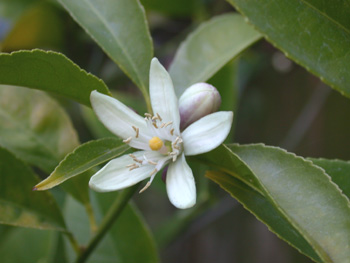 Lemon Flower |
| The ovary of the pistil of the flower will develop into the lemon |
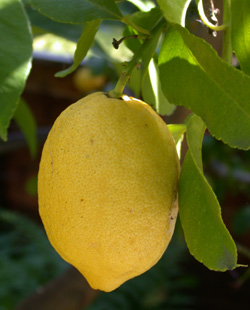 Lemon Fruit |
| Within an ovary of a flower you will find one or more ovules. Each ovule houses an egg. The zygote is formed once the egg is fertilized. The zygote then develops into the embryo (a miniature plant). The rest of the ovule is very important. The outer covering of the ovule develops into a protective seed coat. Not only does the seed coat protect the ovule from physical harm, but also desiccation. There may be an endosperm present in the mature seed (corn, castor bean) or the nutrients are stored within the embryonic leaves (cotyledons). Scarlet runner flowers are pictured below. Scarlet runner beans are a common garden plant, producing long delicious beans. |
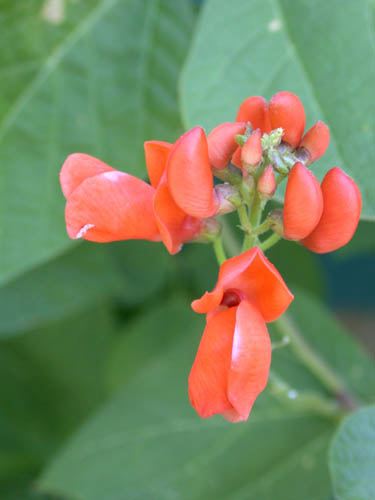 Phaseolus coccineus (scarlet runner) flowers. |
| If the beans of the scarlet runner are permitted to mature you can get a nice harvest of beans. Beans are the mature ovules, or seeds, of this plant. A bean is pictured to the right. |
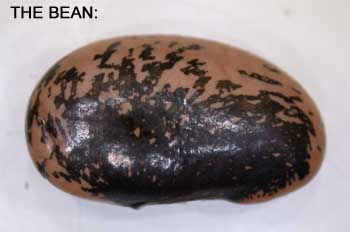 The Seed of a Scarlet Runner |
| Split a bean in half and what do you find? The two large flaps are the cotyledons (nutrient storage). If you look closely you will be able to find the rest of the embryo: new leaves and stem (plumule) as well as the embryonic root (radicle). |
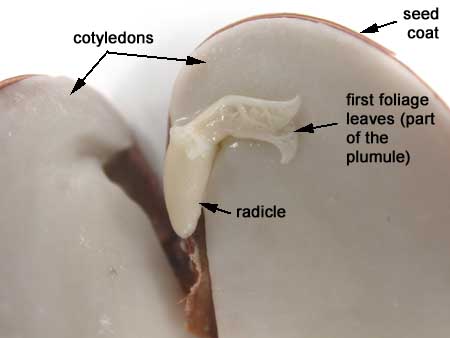 Scarlet Runner Bean Split in Half |
| The developing ovules (seeds) must get nutrients from the parent plant. The point to which the ovule is attached to the ovary is called the placenta. This is where nutrients are transferred to the developing ovule. A cross-section through a cantaloupe fruit reveals parietal placentation (an arrow indicates the placenta). |
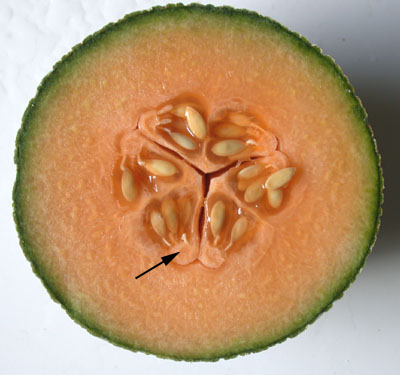 Cantaloupe Cut in Half, to Show Placentation |
| Watermelons are very similar to cantaloupes except there is much more placenta. In fact when you are eating watermelon you are mostly eating placenta…yum! |
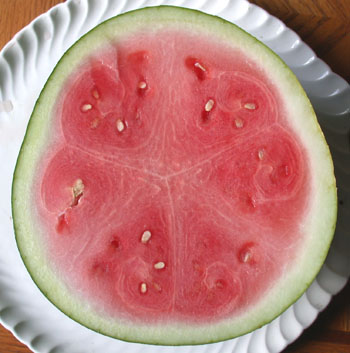 Watermelon Cut in Half |
Ovaries to Fruit
| Tomato plant |
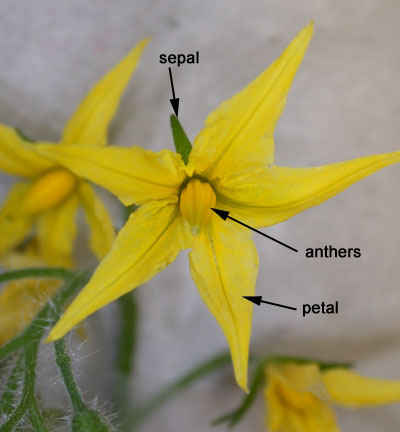 Tomato Flower |
| You can view the ovary better if you remove the petals and stamen. |
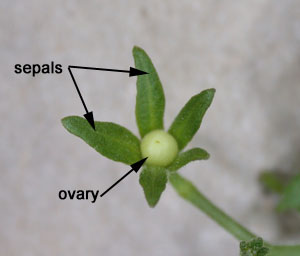 Ovary of Tomato Flower |
| This cross-section through a tomato, shows the many mature ovules (seeds within). The tomato we eat in salads and salsa is actually a fruit! |
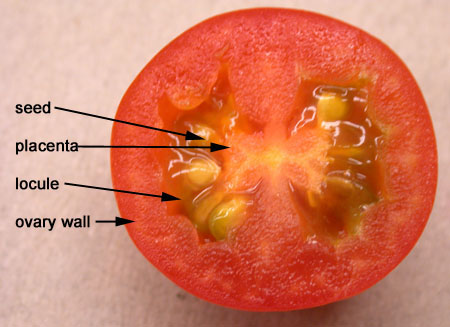 Tomato Fruit in Cross-Section |
| Pea PlantPeas also have flowers with on only one pistil. The pea pod is the fruit and the peas are the seeds. |
 The Fruit of a Pea Plant |
| Look at the close-up of the pea pod. The remnants of the stigma and style are shrivelled up, their missions complete. |
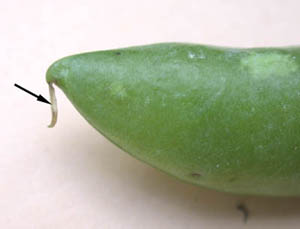 Sepals Still Remain on the Pea Pod |
| A close-up of the other end reveals the sepals. |
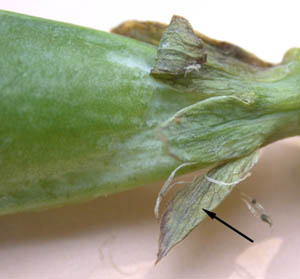 Sepals Still Remain on the Pea Pod |
| If we split the pea pod open we find the seeds (peas) within still attached to the placenta. |
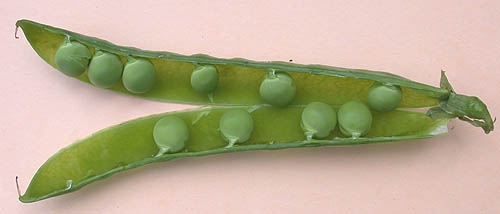 The Pea Fruit, Split Open |
| A cross-section through the pea pod demonstrates the space between the ovary wall and the seed (locule). |
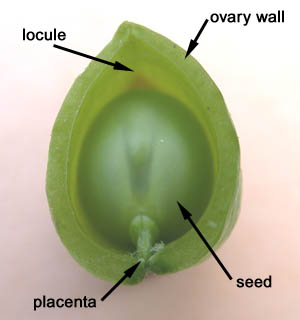 A Fruit of a Pea Plant, in Cross-Section |
| Rubus spectabilis (salmonberry)The salmonberry flower is similar in the strawberry flower in that there are many pistils in one flower. You can see the numerous stigma/styles in the centre of the flower. |
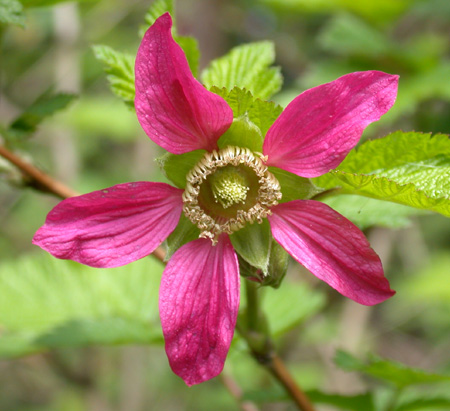 Salmonberry Flower |
| Note the ring of stamens and the hypanthium indicated with a double-headed arrow. |
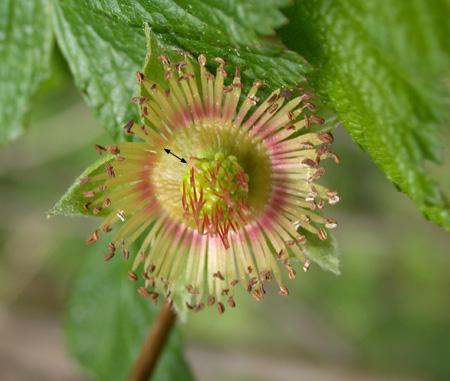 Salmonberry Flower, Petals Removed |
| Salmonberry |
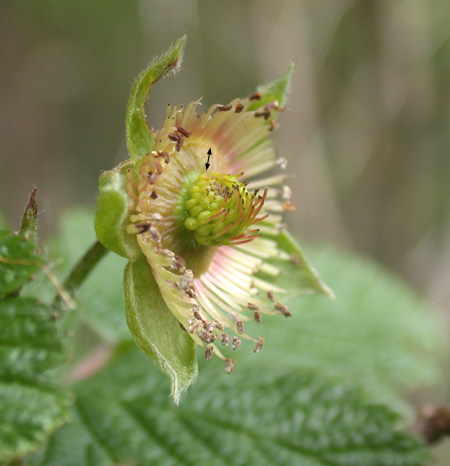 Salmonberry Flower, Petals Removed. Side View. |
| Each ovary develops into a single-seeded “fruit”. In the flower pictured below the ovaries have enlarged and become juicier. Fully developed fruits become apparent . Each of the fruits is called a drupe. In botanical terms the salmonberry is not a berry at all; it is called an aggregate of drupelets. For more information on fruit types you can click here to see the different categories of fruit types. |
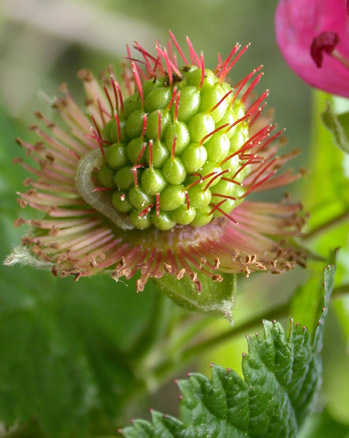 Immature Fruits of a Salmonberry |
| Salmonberry |
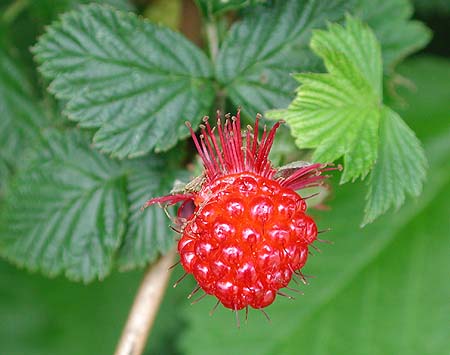 Salmonberry Fruits |
Fruit Variation
Fruits are different shapes, sizes, and textures. The fruit is the vessels in which seeds are found. In many cases the fruit is modified to facilitate the dispersal of the seeds. If a fruit is soft and delicious you would be correct in assuming that animals are generally responsible for the dispersal of the seeds which lie within. If the fruit is dry at maturity then being eaten by animals is not as likely. In this section we will examine different fruits and consider how the seeds are dispersed.
Lonicera involucrata (black twinberry, bearberry honeysuckle).
Here you can see the paired twinberry flowers. |
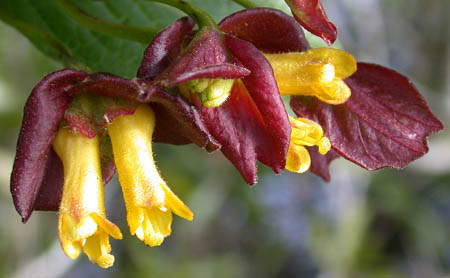 Twinberry Flowers |
| The fruits of this plant are true berries. Why is it not surprising that they are borne in pairs? Although twin berries are generally considered unpalatable to humans (in fact the Kwakwaka’wakw First Peoples of coastal British Columbia believed that eating the berries would make one mute), animals do eat them and distribute the seeds. |
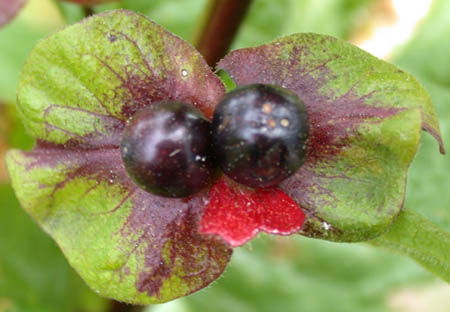 Twinberry Fruits |
Fragaria (strawberry).
The strawberry flower is an example of a plant that has numerous pistils in each flower. |
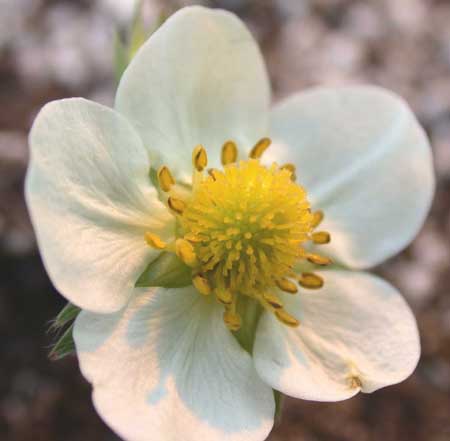 Strawberry Flower |
| The preparation below is a longitudinal section through a flower. Note the numerous pistils. Each ovary will develop into a fruit. |
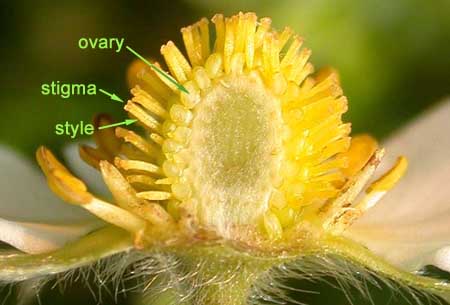 Strawberry Flower, Longitudinal Section |
| Strawberry |
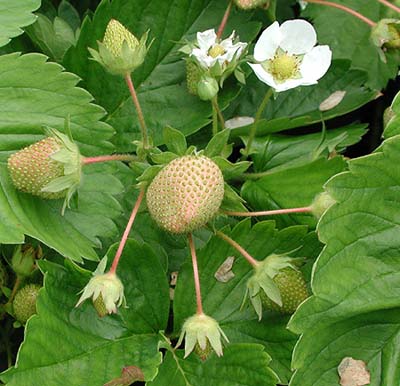 Strawberry Flowers and Fruits |
| On the mature strawberry you can see the remnants of the stamens and sepals. The little seed-like structures scattered over the surface of the red “strawberry” are actually the fruits (each developed from a pistil) called achenes. The red swollen delicious tissue is actually derived from the upper portion of the stem to which the pistils are attached (receptacle). So when you are eating a strawberry you are basically eating a whole bunch of fruits attached to a swollen receptacle! |
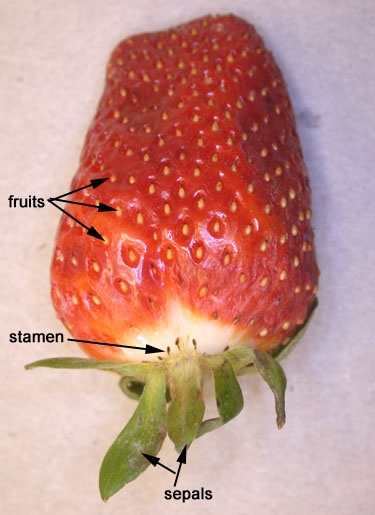 Mature Strawberry |
| Rosa (rose)Here is another example of a structure that is commonly considered a fruit: the rose hip. The beautiful petals and stamen are showy and important pollinator attractants. The pistils are not so obvious because they are found deep within the flower surrounded by a hypanthium. |
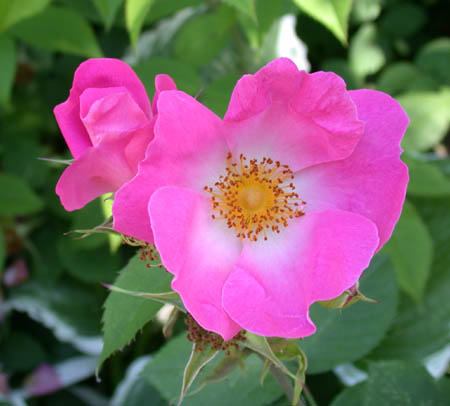 Rose Flower |
| The rose hip you see here is not really the fruit. It is the hypanthium which surrounds the fruits within. |
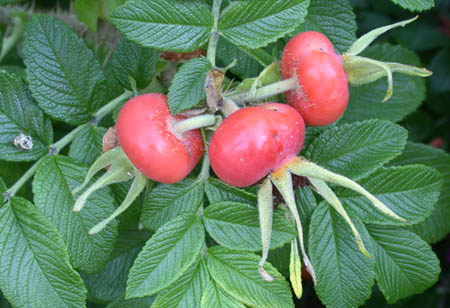 Rosehips |
| The longitudinal section below shows the hard little achenes within the rose hip. The rose hip is often used in preparations (tea etc) as a source of vitamin C. |
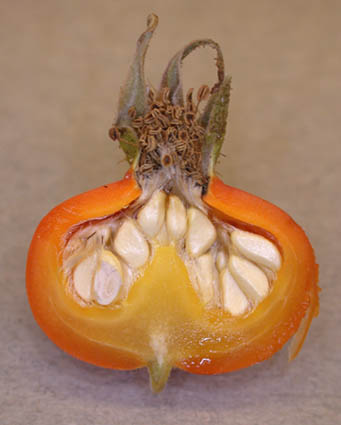 Longitudinal Section Through a Rosehip |
| Cirsium (thistle)Thistles are actually a head of many small flowers. Each flower produces one fruit each containing one seed. What type of fruit type is this? |
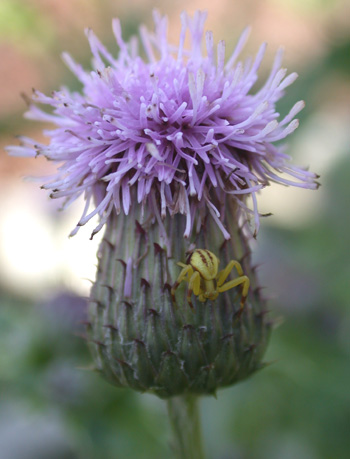 Thistle Inflorescence |
| One thistle will produce many fruits. |
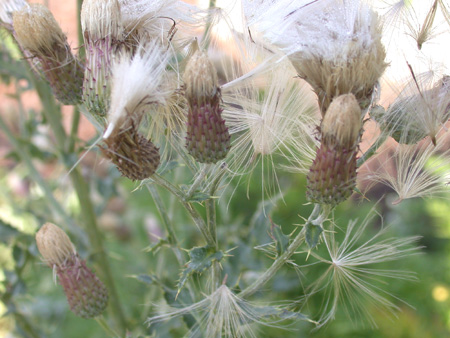 Thistle, Gone “to Seed” |
| In the picture to the right you can see each fruit has hairlike extensions. What is the dispersal unit in this plant? How do you think the seeds are dispersed in this plant? |
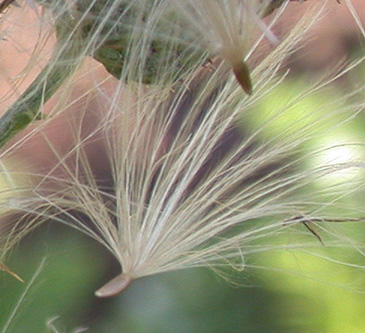 Thistle Fruit, Close Up |
Cardiocrinum (giant lily)
Lilies also have fruits which are not soft and edible. They are capsules which dehisce (open) when mature. Within the capsule you can see the hundreds of flat seeds. |
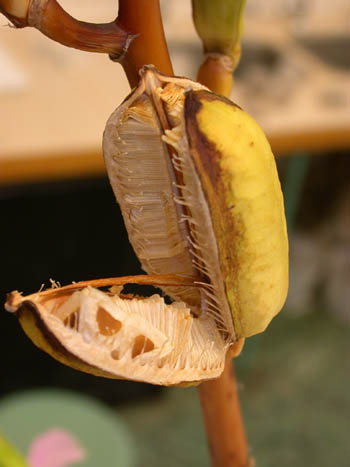 Capsule of Cardiocrinum |
| The seeds of lilies commonly have winged edges. In this case the seeds are the dispersal units. |
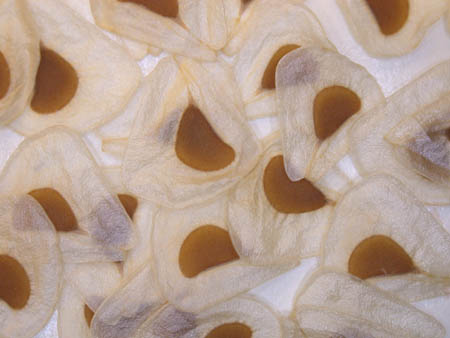 Cardiocrinum Seeds, Flat With Winged Edge |
Fruit Types.
Back to Lab 1.


































